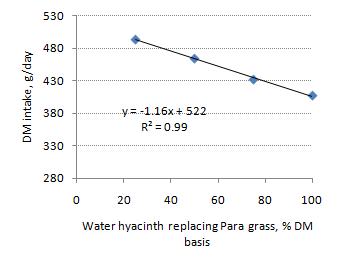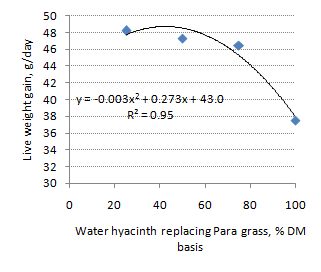

|
MEKARN Conference 2010 |
This study aimed to evaluate effects of different levels of fresh water hyacinth (WH) replacing Para grass on nutrient digestibility, rumen parameters, microbial protein synthesis and nitrogen retention of growing goats. Four female goats were arranged in a Latin-square design with four treatments, which included fresh water hyacinth levels replacing Para grass at levels of 25, 50, 75 and 100%. (DM basis). Soybean cake and urea were supplemented in all the diets to adjust the daily CP intake to 6 g CP/kg BW.
DM intake decreased linearly (Figure 1) with increasing replacement of para grass by WH. Rumen N-NH3 and VFA concentration also when increasing WH in the diets. No significant difference was found in apparent digestibility coefficients of proximate components nor in nitrogen retention. The daily weight gain declined with a negative curvilinear trend (Figure 2) as WH replaced Para grass Purine derivatives and microbial protein synthesis tended to decrease with increasing level of WH.
It was concluded that fresh water hyacinth could replace Para grass in goat diets up to 75% without any negative effects.
 |
 |
| Figure 1; Effect on DM Intake of goats of replacing Para grass with water hyacinth | Figure 2; Effect on weight gain of goats of replacing Para grass with water hyacinth |
Keyword: water hyacinth, goat, intake, rumen parameters, digestion, nitrogen retention, microbial protein synthesis